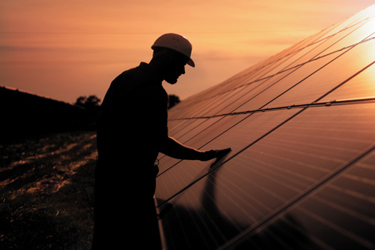Technology And Its Role In The Utility Field Service Industry
By Chad Hall, Panasonic Connect

This past September, Hurricane Ian caused catastrophic damage and, while estimates are still undetermined, repairs are expected to cost tens of billions of dollars. During the worst of the storm, it was reported that approximately 2.7 million Floridians lost power. Businesses and families were evacuated, displaced with unknown timelines on return, and wondering what state their livelihood would be in. Millions experienced emotional, physical, and financial stress. The road to recovery begins with a coordinated response to eliminate hazards, provide critical resources, and restore conditions.
In the wake of these events, communities depend on utility field service workers — who are in high demand — to help resume normal function. No matter what the challenge is — weather events, environmental catastrophes, or unpredictable downtime — utility workers provide critical support to businesses and communities. From restoring power and utility services to clearing debris and fixing structures, field service work often calls for unpredictable hours and flexible workflows to make sure everything runs smoothly.
Workers need the right mobile computing technology at their fingertips to make informed decisions and operate effectively in the field. Without them, both the workers’ and customers’ experiences will suffer, and businesses and families risk lengthier delays in getting their lives back.
In-Field Communication
Critical communications are increasingly important in emergencies especially when infrastructure—whether electric, gas or communications—is down. Stable communication systems that allow workers to connect to a job site, each other, and a central command hub, regardless of circumstance are a requirement. Having a powerful cloud computing communications system isn’t effective if it can’t connect to the right channels.
Connected communication systems change the way that workers engage with each other, and how they conduct services and support. Connectivity supports transmitting critical messages to-and-from teams, pinpointing outage locations, and estimating restoration times. To ensure reliability and usability, the solutions that are used by field service workers must have a wide range of network capabilities from cellular to Bluetooth to GPS. This keeps workers connected regardless of external infrastructure issues, minimizes downtime, and eliminates hindrances to productivity.
Connectivity also opens doors to improved operations, including more accurate resource tracking and management. The ability to know what equipment and resources workers have on hand, exactly where assets are being deployed, and access to real-time visibility as pieces move around, can change how a situation is managed. It also keeps workers informed, in real-time, at the point of service.
Situational Awareness
From checking pipes and wires to surveying potentially hazardous areas, field service workers need to be fully aware of their surroundings, as well as potential challenges that could be lurking around the corner. Presenting this information at a worker’s fingertips, via a laptop or handheld device, lets teams optimize resources and make a better decision. But data streaming in from various disparate sources doesn’t provide a complete picture of the situation if it isn’t parsed and delivered to the teams on the ground.
Today, many field service operations use rugged laptops or handhelds as a “single pane of glass” where various information streams flow to create a holistic picture of the situation at hand. This level of awareness, from weather patterns to diagnostic prints and plans, to the location of other resources gives workers a more complete view of what happens both in and out of the field.
In addition, full situational awareness allows utility workers to be deployed in a way that makes both fiscal and operational sense and shifts them from reactive response to preventative response. For example, drones and sensor networks are providing new types of information such as moisture levels or temperatures that can help predict or more quickly address potential issues. This means that workers, equipment, and resources can be more accurately deployed to service situations before they escalate further.
Optimized Service
Starting with a connected, reliable solution at the utility field service worker’s side, all the way through to the new sensor, IoT, and technology ecosystems, customer outcomes and worker experiences are improved. Not having to chase down information, question the location of critical resources, or guestimate on restoration time helps workers optimize services and better inform those in need. Rugged field technology also aids field service workers in maximizing productivity and eliminating downtime, and ultimately delivering the biggest positive impact to affected communities—a quick resumption of services.
The utility field service industry will see a continued focus on the deployment of technologies to modernize the way service is provided. Rugged technology solutions offer immeasurable value, and utility service operations that leverage the right mobile computing technology will find that they can deliver on the promise of restored power, cleaned debris, and hazard elimination faster. As a result, the people, families, and businesses served in the community will benefit, and be able to start their rebuilding processes sooner
About The Author
Chad Hall is Strategic Account Manager, Panasonic Connect, Utility & Enterprise Mobility Solutions.
